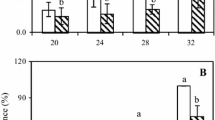Abstract
The volatile antimicrobial substance allicin (diallylthiosulphinate) is produced in garlic when the tissues are damaged and the substrate allicin (S-allyl-l-cysteine sulphoxide) mixes with the enzyme alliin-lyase (E.C.4.4.1.4). Allicin undergoes thiol-disulphide exchange reactions with free thiol groups in proteins and it is thought that this is the basis of its antimicrobial action. At 50 μg ml-1, allicin in garlic juice inhibited the germination of sporangia and cysts and subsequent germ tube growth by Phytophthora infestans both in vitro and in vivo on the leaf surface. Disease severity in P. infestans-infected tomato seedlings was also reduced by spraying leaves with garlic juice containing allicin over the range tested (55–110 μg ml−1) with an effectiveness ranging from approximately 45–100%. Similarly, in growth room experiments at concentrations from 50–1,000 μg ml−1, allicin in garlic juice reduced the severity of cucumber downy mildew caused by Pseudoperonospora cubensis by approximately 50–100%. These results suggest a potential for developing preparations from garlic for use in specialised aspects of organic farming, e.g. for reducing pathogen inoculum potential and perhaps for use under glass in horticulture.







Similar content being viewed by others
References
Abbott, W. S. (1925). A method for computing the effectiveness of an insecticide. Journal of Econonomic Entomology, 18, 265–267.
Ark, P. A., & Thompson, J. P. (1959). Control of certain diseases of plants with antibiotics from garlic (Allium sativum L.). Plant Disease Reporter, 43, 276–282.
Block, E. (1992). The organosulfur chemistry of the genus Allium – implications for the organic chemistry of sulfur. Angewandte Chemie International Edition in English, 31, 1135–1178.
Carmichael, J. W. (1955). Lacto-fuchsin: A new medium for mounting fungi. Mycologia, 47, 611.
Cavallito, C. J., & Bailey, H. J. (1944). Allicin, the antibacterial principle of Allium sativum I. Isolation, physical properties and antibacterial action. Journal of the American Chemical Society, 66, 1950–1951.
Curtis, H., Noll, U., Störmann, J., & Slusarenko, A. J. (2004). Broad-spectrum activity of the volatile phytoanticipin allicin in extracts of garlic (Allium sativum L.) against plant pathogenic bacteria, fungi and Oomycetes. Physiological and Molecular Plant Pathology, 65, 79–89.
Gisi, U. (2002). Chemical control of downy mildews. In P. T. N. Spencer-Phillips, U. Gisi, & A. Lebeda (Eds.), Advances in downy mildew research (pp. 119–159). Dordrecht: Kluwer Academic Publishers.
Gorog née Privitzer, K., Kocsis née Bagyi, M., Orosz, G., Torok, T., Laszlo, K., Toth, I., et al. (1988). Herbicide compositions containing a nitrile derivative as antidote. US Patent 4787933.
Jeger, M. J. (1987). Modelling the dynamics of pathogen populations. In M. S. Wolfe, & C. E. Caten (Eds.), Populations of plant pathogens: Their dynamics and genetics (pp. 91–107). Oxford: Blackwell Scientific Publishers.
Konstantinidou-Doltsinis, S., Markellou, E., Fanouraki, M. N., Kasselaki, A.-M., Koumaki, C. M., Schmitt, A., et al. (2006). Efficacy of MilsanaÒ, a formulated plant extract from Reynoutria sachalinensis, against powdery mildew of tomato (Leveillula taurica) (Lév.) Arn. Biocontrol, 51, 375–392.
Konstantinidou-Doltsinis, S., & Schmitt, A. (1998). Impact of treatment with plant extracts from Reynoutria sachalinensis (F. Schmidt) Nakai on disease severity of powdery mildew and yield in cucumber under Greek conditions. Crop Protection, 17, 649–656.
Körösi, K., Lazar, N., & Viranyi, F. (2007). Resistance response to downy mildew (Plasmopara halstedii) in sunflower (Helianthus annuus) activated by chemical inducers. In A. Lebeda, & P. T. N. Spencer-Phillips (Eds.), Advances in downy mildew research (vol. 3 (pp. 237–241). Czech Republic: Olomouc, Palacky University (Publishers).
Krest, I., & Keusgen, M. (2002). Biosensoric flow-through method for the determination of cysteine sulfoxides. Analytica Chimica Acta, 469, 155–164.
Mauch-Mani, B. (2002). Host resistance to downy mildew diseases. In P. T. N. Spencer-Phillips, U. Gisi, & A. Lebeda (Eds.), Advances in downy mildew research (pp. 59–83). Dordrecht: Kluwer Academic Publishers.
Miron, T., Rabinikov, A., Mirelman, D., Wilchek, M., & Weiner, L. (2000). The mode of action of allicin: Its ready permeability through phospholipid membranes may contribute to its biological activity. Biochimica et Biophysica Acta, 1463, 20–30.
Portz, D., Noll, U., & Slusarenko, A. J. (2005) Allicin from garlic (Allium sativum L.): A new look at an old story. Proceedings of the 14th International Reinhardsbrunn Symposium, “Modern Fungicides and Antifungal Compounds IV”. Eds. H.-W. Dehne, U. Gisi, K. H. Kuck, P. E. Russell & H. Lyr. British Crop Protection Council, Alton, U.K. pp. 227–234.
Rabinikov, A., Miron, T., Konstantinovski, L., Wilchek, M., Mirelman, D., & Weiner, L. (1998). The mode of action of allicin: Trapping of radicals and interaction with thiol-containing proteins. Biochimica et Biophysica Acta, 1379, 233–244.
Russell, P. E., & Mussa, A. E. A. (1977). The use of garlic (Allium sativum) extracts to control foot rot of Phaseolus vulgaris caused by Fusarium solani f. sp. phaseoli. Annals of Applied Biology, 86, 369–372.
Slusarenko, A. J., Patel, A., & Portz, D. (2008). Control of plant diseases by natural products: Allicin from garlic as a case study. European Journal of Plant Pathology, 121, 313–322.
Urban, J., & Lebeda, A. (2006). Fungicide resistance in cucurbit downy mildew—methodological, biological and population aspects. Annals of Applied Biology, 149, 63–75.
Urban, J., & Lebeda, A. (2007). Variation for fungicide resistance in Czech populations of Pseudoperonospora cubensis. Journal of Phytopathology, 155, 143–151.
Urban, J., Lebeda, A., & Pejchar, M. (2007). Differential sensitivity to fungicides in Czech populations of cucumber downy mildew (Psedoperonospora cubensis). In A. Lebeda, & P. T. N. Spencer-Phillips (Eds.),Advances in downy mildew research (vol. 3 (pp. 251–255). Czech Republic: Olomouc, Palacky University (Publishers).
Acknowledgements
RWTH Aachen University provided a student assistantship (D.P.) and financial support. Technical assistance by Ulrike Noll (Aachen) and Monika Eitzen-Ritter (Darmstadt) is gratefully acknowledged. Ales Lebeda and Nikolaus Schlaich are thanked for critical reading of the manuscript.
Author information
Authors and Affiliations
Corresponding author
Rights and permissions
About this article
Cite this article
Portz, D., Koch, E. & Slusarenko, A.J. Effects of garlic (Allium sativum) juice containing allicin on Phytophthora infestans and downy mildew of cucumber caused by Pseudoperonospora cubensis . Eur J Plant Pathol 122, 197–206 (2008). https://doi.org/10.1007/s10658-008-9334-x
Received:
Accepted:
Published:
Issue Date:
DOI: https://doi.org/10.1007/s10658-008-9334-x



